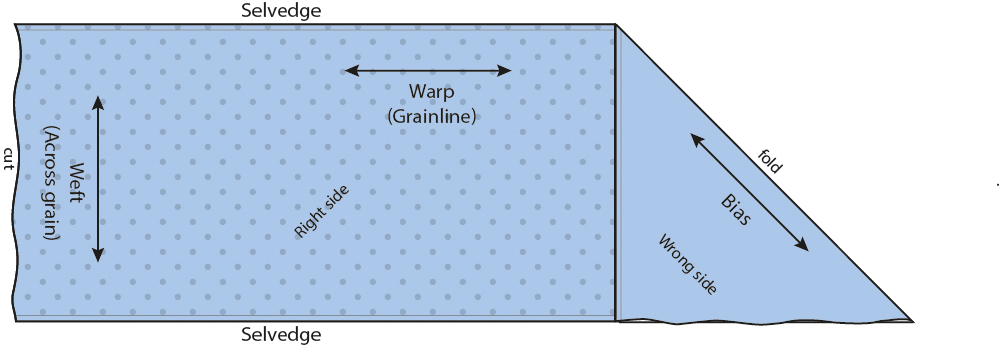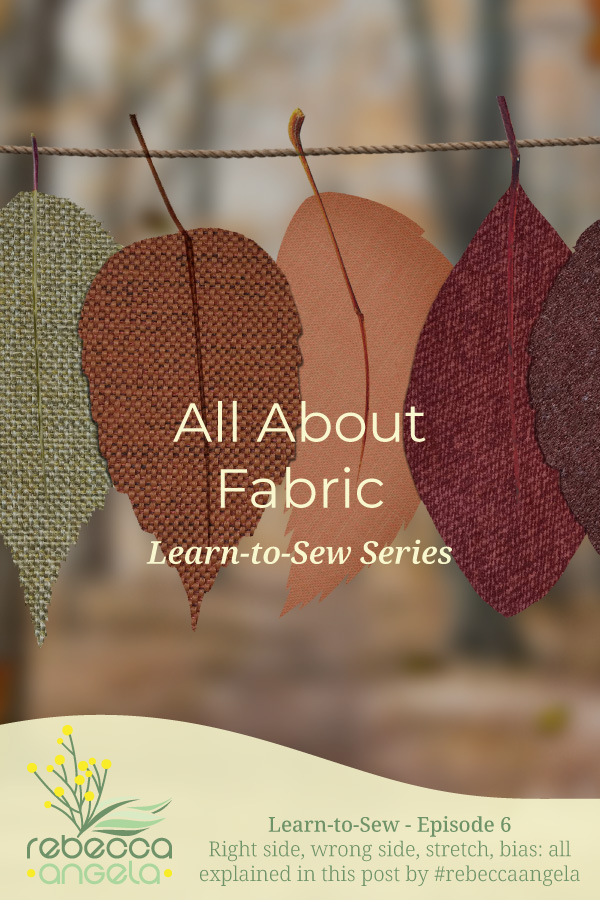Today we are talking about fabric. I don’t need to tell you that fabric comes in a dizzying array of types and weights but understanding fabrics will help you choose the right fabric for your project as well as prepare you for working with that fabric successfully.
I mentioned in Finding Your Sewing Zen that knit fabrics require special techniques but what exactly is a knit fabric? Well, let’s see…
Types of Fabric
Fabrics are different from one another due to a range of factors. Let’s look at each of these in turn.

Construction
Fabrics are either woven, knitted or bonded (non-grain/non-woven).
Woven fabrics are constructed with one set of threads (the weft) running across the lengthways (warp) threads. The weft threads are woven in and out of the warp threads in different patterns to create different effects. They generally have little stretch due to the construction method but some stretch can be achieved with an elastic thread – think of stretch denim which incorporates some spandex to allow for some stretch. Woven fabrics typically fray because the weft threads fall off the cut end of the warp threads. Examples of woven fabrics are denim, cotton poplin and silk shantung.
Knit fabrics are constructed by looping the yarn or thread through itself. There are different processes producing different results but knit fabrics have stretch because of their construction method. Knit fabrics tend to unravel rather than fray (think of the jumper your grandmother knitted you) although most machine knits are pretty stable due to the complex knitting process employed.
Bonded or nonwoven fabrics are created by bonding fibres together with processes involving chemicals, heat or some kind of mechanical process. Felt is the most common example of a bonded fabric.
Weave type
The names we know for a number of fabrics are actually the names of the weave pattern used such as twill and satin. Weaves differ in the number of warp threads that the weft thread passes over before being brought to the underside again (or visa versa). This creates patterns such as the diagonal rib of cotton drill. The sheen of satin fabrics comes from seeing a greater amount of the warp thread.
Fibre
Fibres are either man-made (synthetic) or natural of course but there is a huge variety within each of these categories. Each different source of fibre yields different characteristics such as lustre and strength. And natural and synthetic fibres are often mixed together in a fabric to produce certain qualities. Poly-cottons are a common example and so is the stretch denim mentioned above.
Natural fibres come from plants or animals and include cotton, linen and hemp (plant) and silk and wool (animal). Synthetic fibres are made from chemical compounds. Some have a base of the cellulose polymers found in nature (rayon and acetate) and others are completely chemically produced, often from petroleum (nylon and polyester).
Thread or yarn thickness
Fabric fibres are generally too thin to be woven or knitted into fabric singularly. The fibres are twisted together into thread or yarn. Yarn thickness is determined by the thickness of the original fibre and the number of fibres twisted together. The fabric weight (and strength) then is determined by the thickness of the yarn and the density of the weave or knit. The more threads per inch the denser the fabric. You often see this referred to as thread count on sheeting for example and the higher the thread count the better quality the sheets.
Working with Fabric
Shrinkage
We are probably all aware of the risk of shrinkage of fabrics when they are washed. This doesn’t just happen if you wash something in hot water when it should be washed in cold (think again of that jumper your grandmother knitted you). Many fabrics shrink on first washing. It is a good rule to wash the fabrics you buy before you cut them out so that, if they are going to shrink, they do so before you have sewn them to size in a garment! Not only that, but they usually have chemical finishers in them which can cause skin irritation.
My tip is to put your new fabrics into the wash as soon as you get them home so that they will be ready to cut out when you can grab yourself a little bit of sewing time. Take note of the fabric care instructions for your fabric though. If it is a dry-clean only fabric, don’t wash it! Fabric care instructions are sometimes on the label attached to the fabric roll. Sometimes they can be printed out by the sales assistant at the cash register so take advantage of this (it will also list the fibre content and type of fabric). If you are in doubt about fabric care, ask Mr Google – of course that requires that you know what fabric you are dealing with in the first place.
If you are never going to wash your finished item, you can get away without washing the fabric first but just to be on the safe side…
Grain

Now that you understand fabric construction you will understand fabric grain. The grain of the fabric follows the lengthways or warp threads. Most patterns ask that you line up the pattern piece with the grain so that, for example, the fabric warp threads will run down your body if you are making a garment (unless it is cut on the bias – I’ll get to that in a minute!) This is less important for a cushion perhaps but many times any pattern printed on the fabric will run the length of the fabric and this will be the way you want it to run on your finished piece anyway. Your pattern will also refer to the selvedge of the fabric too. The selvedge is the fray-stable edge of the fabric which run lengthways down both sides of the fabric. This is a quick way to work out the warp from the weft but if you are working with a small piece of fabric from your stash where the selvedge has been cut off long ago, you will find that the fabric (even woven fabrics without ‘stretch’) will stretch a little more across-wise than lengthwise.
Bias
Sometimes fabric is cut on the bias. You may have heard of a skirt being ‘cut on the bias’ to give it a lovely drape. This means the pattern has been laid diagonally across the fabric. The fabric bias is the line running 45° across the warp fibres. If you take the squared off cut end of the fabric and fold it over to the selvedge the resulting diagonal is the bias of the fabric. If you are working with a pattern to be cut on the bias the grainline will be shown on the pattern piece on this angle so make sure you line it up with the warp threads (parallel to the selvedge).
Right Side and Wrong Side
Fabric has a right side and a wrong side. This is pretty obvious on some printed fabrics because it is printed on one side and the ink doesn’t really come through to the other side. The right and wrong side of many fabrics are much more difficult to determine. If a fabric, such as a tartan, has the pattern woven into the fabric, it will look very similar from one side to the other. Sometimes there will be more of a texture on the right side, sometimes it will be shinier. Sometimes looking at the selvedge will give you a clue. If you really can’t tell one side from the other, it probably doesn’t matter but work it out if you can. And, whichever side you choose, make sure you are consistent. Sometimes an imperceptible difference becomes perceptible if placed side by side on a project!
When you are cutting out, it is usual to fold the fabric to make identical multiples of pieces or to simultaneously cut both sides of a symmetrical piece (this will be cut ‘on the fold’). We will talk more about cutting out in a later post but in the meantime just know that fabric is usually folded right sides together.
Also, when you are sewing the pattern will refer to the right and wrong side of the fabric or it might say ‘with right sides together’. This is important for the proper construction of your project so take note. Seams are usually sewn right sides together so that the resulting seam allowance is inside the project when finished. Again we will cover this in more detail in a later post.
Nap and One-Way Pattern
Whilst talking about right and wrong sides it is worth also mentioning fabric nap. Some fabrics are made with pile (think velvet) and the fabric looks a very different colour depending on whether it is viewed one way or the other because of the way the light bounces off the fibres. This is called ‘nap’. So take extra care cutting out velvet, suede, corduroy, imitation furs and that sort of thing. Each piece of the pattern must be cut with the nap heading the same way. This also applies to one-way patterns. A one-way pattern is a pattern that looks different if it is upside down. Imagine a repeat print of apples. If all the apples are aligned the same way, if you turn the fabric upside down, the apples will be resting on their stalks! Most patterns will give different layout instructions for ‘with nap’ fabric. Use these instructions for one-way or one-directional patterned fabric too.
Pattern Fabric Suggestions
A commercial pattern envelope will give you suggested fabrics for your project. It is important to try and make sense of these suggestions because the weight, drape and stretch of the fabric will make a significant difference to the outcome. When a pattern says “sized for stretch knits only” it means if you make it with a woven fabric, you may not be able to get it over your head to wear it! By way of another extreme example, imagine making a summer blouse where the suggestion is crepe and instead you choose a cotton drill. It will not drape in the way the designer intended and you will be disappointed in the result – not to mention very warm! Similarly, a bias cut skirt requires a lighter weight, ‘drapey’ fabric such as georgette and will not work in denim. Wikipedia has an enormous list of fabric types but the links are to rather technical explanations. Walking around your fabric store looking at labels and feeling the fabrics is a good way to learn the different fabric types. Look at the clothes and other items in your home and see if you can determine what they are made with. The care label, where present, will obviously give you a bit of a clue (cotton or polyester?) but they will not be labelled ‘crepe’ or ‘georgette’ and these are exactly the suggestions on the pattern envelope I found so confusing when I was starting out. It can be difficult to get good service in some of the large fabric and craft stores but, in an ideal world, sales assistants should be able to assist. If you have a good specialty store near you – one that is really serious about fabrics – that would be a good place to take an educational excursion.
I hope that has cleared up some of the questions you had about fabric type. If you have a further question, ask me in the comments below!

